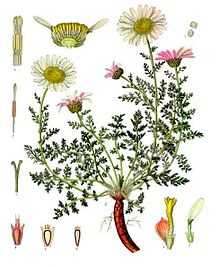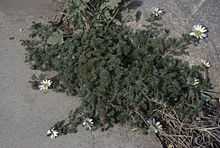Anacyclus pyrethrum
| Anacyclus pyrethrum | |
|---|---|
 | |
| Mount Atlas daisy | |
| Scientific classification | |
| Kingdom: | Plantae |
| (unranked): | Angiosperms |
| (unranked): | Eudicots |
| (unranked): | Asterids |
| Order: | Asterales |
| Family: | Asteraceae |
| Tribe: | Anthemideae |
| Genus: | Anacyclus |
| Species: | A. pyrethrum |
| Binomial name | |
| Anacyclus pyrethrum (L.) Link | |
| Synonyms | |
|
Anthemis pyrethrum L. | |
Anacyclus pyrethrum (pellitory, Spanish chamomile, or Mount Atlas daisy) is a perennial herb much like chamomile in habitat and appearance. It is in a different family (Asteraceae) from the plants known as pellitory-of-the-wall (Parietaria officinalis) and spreading pellitory (Parietaria judaica).
It is found in North Africa, elsewhere in the Mediterranean region, in the Himalayas, in North India, and in Arabian countries.
Medicinally, pellitory root has a pungent efficacy in relieving toothache and promoting a free flow of saliva and making it popular as a food spice. It induces heat, tingling and redness when applied to the skin.
Although one might assume from the pyrethrum suffix that this plant may contain pyrethrins, it does not. The second part of the binomial name stems from the Ancient Greek name for the plant, πύρεθρον,[3] whereas the pyrethrins are named after Pyrethrum, used more recently for several plants of the genus Chrysanthemum some of which do contain pyrethrins.[4]
Ayurveda (the ancient Indian medicine system) and Siddha (the medicine system from Tamil Nadu, a southern state of India) have more uses for this plant root and it has been used for centuries as a medicine. It is called Akkal-Kara in Hindi, Akkal Kadha in Marathi, and Akkarakaaram (Tamil: அக்கரகாரம்). An oil is prepared by a method known as pit extraction (Tamil: குழி எண்ணெய்).
More recently Anacyclus pyrethrum has been noted for its anabolic activity in mice and suggests to give a testosterone-like effect, and also significantly increasing testosterone in the animal model.[5][6]
The variety depressus (sometimes considered a separate species, Anacyclus depressus), called mat daisy or Mount Atlas daisy, is grown as a spring-blooming, low-water ornamental.
Distribution
Sources: GRIN,[7] E+M,[1] AFPD[2]
References
- ↑ 1.0 1.1 Botanic Garden and Botanical Museum Berlin-Dahlem. "Details for: Anacyclus pyrethrum". Euro+Med PlantBase. Freie Universität Berlin. Retrieved 2008-06-16.
- ↑ 2.0 2.1 "Anthemis pyrethrum record n° 135636". African Plants Database. South African National Biodiversity Institute, the Conservatoire et Jardin botaniques de la Ville de Genève and Tela Botanica. Retrieved 2008-06-16.
- ↑ A Greek-English Lexicon by Liddell/Scott/Jones (LSJ), entry πύρεθρον.
- ↑ http://users.skynet.be/bertram.zambiafoundation/Afbeeldingen/Literature_revue_Pyrethrum_root.pdf
- ↑ http://www.scipharm.at/download.asp?id=346
- ↑ http://www.ncbi.nlm.nih.gov/pubmed/22473789
- ↑ Germplasm Resources Information Network (GRIN) (1994-08-23). "Taxon: Anacyclus pyrethrum (L.) Link". Taxonomy for Plants. USDA, ARS, National Genetic Resources Program, National Germplasm Resources Laboratory, Beltsville, Maryland. Retrieved 2008-06-16.
External links
![]() Media related to Anacyclus pyrethrum at Wikimedia Commons
Media related to Anacyclus pyrethrum at Wikimedia Commons
![]() Data related to Anacyclus pyrethrum at Wikispecies
Data related to Anacyclus pyrethrum at Wikispecies
- UniProt. "Anacyclus pyrethrum" (HTML). Retrieved 2008-06-16.
- M. Grieve (1931). "Pellitory". A Modern Herbal. © Copyright Protected 1995-2008 Botanical.com. Archived from the original on 9 July 2008. Retrieved 2008-06-16.
-

Var. depressus
-

same plant, flower detail
-

Var. depressus, flowers closed